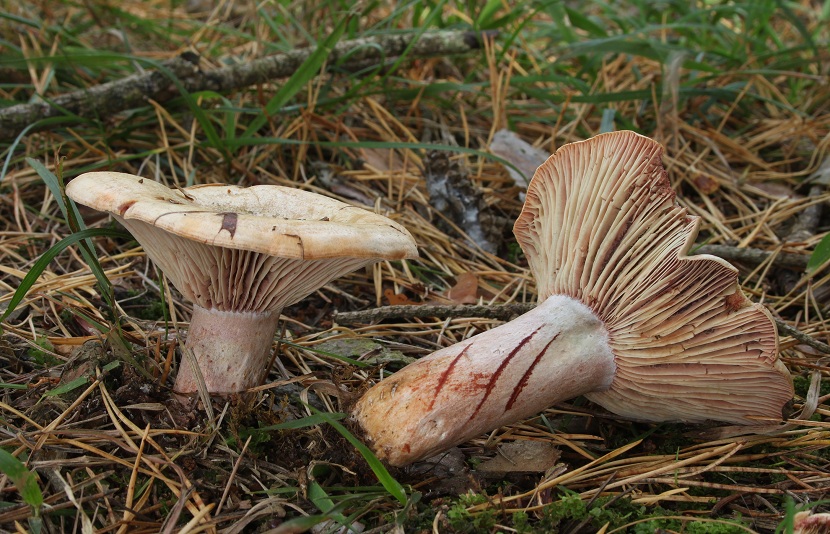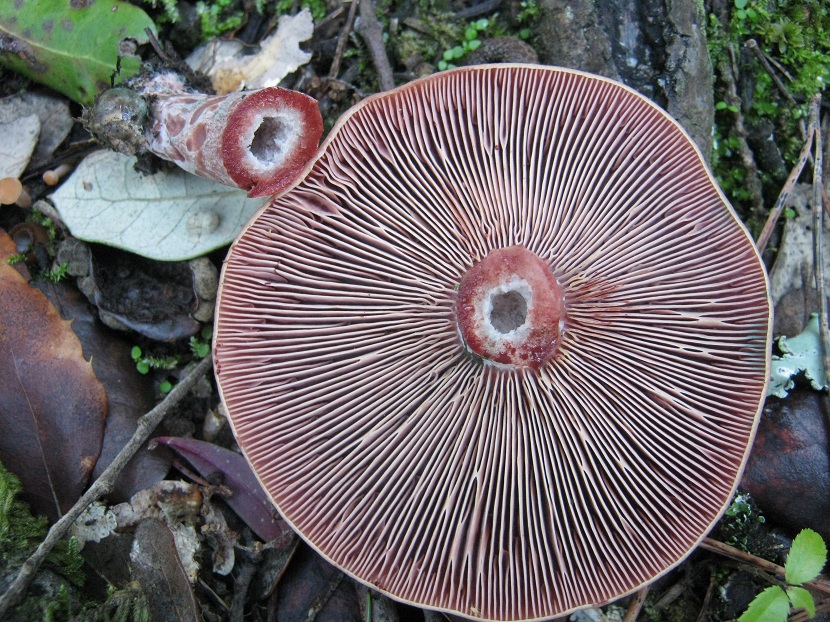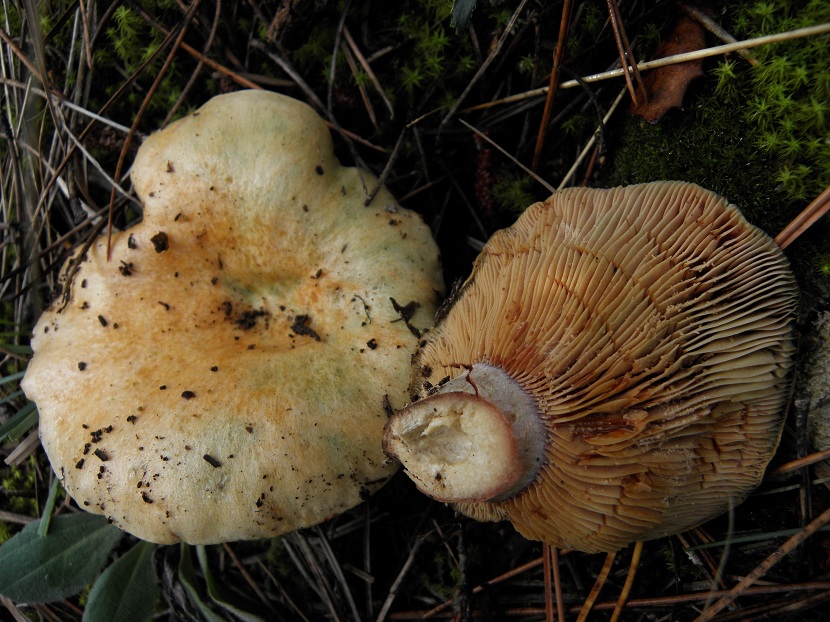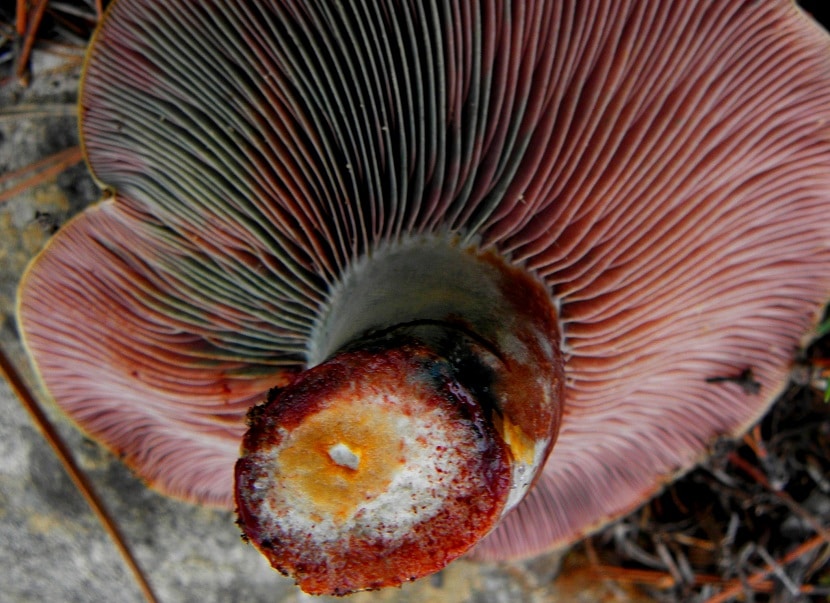
Today we are going to talk about one of the most recognized mushrooms in Catalonia for being edible and easily distinguishable. Its about Lactarius sanguifluus. Its common name is nízcalo with vinosa blood. They can be easily distinguished from their companion A lovely milkman thanks to the color of its meat when cut. It is easier to find than its mate and is considered a better edible.
In this article we are going to tell you everything you need to know about the Lactarius sanguifluus.
Key features

It has a hat with a diameter that ranges between 5 and 10 centimeters although, occasionally, they can become larger. As they develop, they acquire a convex shape with a more flattened center. This species, unlike others, does not become completely flattened. The surface of this hat can be recognized with the naked eye for being dry as a multitude of stripes and with a pale ocher color. You can see a certain orange hue but never a full orange color.
It has a large number of blades, uneven morphology and quite tight one from the other. It also has small lamellae that are pale okra to orange in color. As the fungus develops and grows, it acquires a vinous red or purple color, hence its common name. When this fungus has some type of wound, it usually exudes a type of wine-red latex.
As for the foot, it is generally quite long and short although it has a robust appearance. In the young specimens we can find the foot is quite full and then it is hollowed out. Its color is quite light, almost white sometimes and a purple hue. The most normal thing is that we find dark wine red scrobicles on the foot.
The meat of this mushroom is edible and a delight. Among its characteristics we have thick and solid meat of a pale ocher color. Sometimes we can find some specimens with the flesh almost white in color and cut by the latex that exudes a wine-red color. This is the characteristic that differs the most from the rest of mushrooms; it has a pleasant smell and a mild flavor, although slightly spicy if consumed raw.
Habitat and area of distribution Lactarius sanguifluus

It is a fairly common and frequent species in some areas and practically non-existent in others. It can be found forming mycorrhiza in pines, especially under pines of the species (Pinus sylvestris). The altitudes at which it usually develops and finds a large number of these are between 700 and 900 meters high. We can also find them in pine forests such as rockrose.
Its development begins in the autumn season. Normally, the habitat where it can best grow is in those areas that have a shady undergrowth, rich in smoke and with a lot of humidity. As for the soil, it prefers in calcareous soils and grows under the fallen needles of the pines. In Murcia we find a greater number of specimens that are used to growing near star mosses.
They are capable of producing isolated fructifications next to the pines or under the nearby oaks or surrounding bushes. When it forms mycorrhizae, they are exclusively placed under the pines and you will not be able to find these specimens outside the mature forests of species of the genus Pinus. The Lactarius sanguifluus is widely distributed in all the forest formations of these conifers that we have in the Iberian Peninsula. In particular, we find a greater number of specimens in areas where we have a Mediterranean climate.
We can also find them in some coastal areas and mountain ranges, but they are less frequent since the environmental conditions for fruiting do not occur every year. It needs enough humidity and abundant rainfall so that they can develop in good conditions.
Uses of Lactarius sanguifluus

It is a very popular mushroom in the culinary world. In many areas of Spain it is considered a good edible and better than many of the chanterelles. The A lovely milkman It is one of the species of this genus considered to have a good quality for the preparation of different dishes. East A lovely milkman can be differentiated from Lactarius sanguifluus in which It has an orange hat with bright tones and an orange latex detachment.
The most abundant harvest of this fungus is in November. It is the favorite of all Murcians who are looking for mushrooms during the autumn season. There are even traditions of consuming this mushroom in the northwest region since it can only be found during this time of year. The hobby of collecting this mushroom every year is a challenge to do so in large quantities. Being very easy to recognize oneself, challenges are made to see who is capable of collecting the most amount of Lactarius sanguifluus.
To collect this type of mushroom it is not necessary to be an expert since it is quite easy to recognize it. In addition, its meat is quite pleasant and tasty on the palate. It is likely that it is considered in the species of the genus Lactarius that has a higher gastronomic quality together with the Lactarius delicious.
In these areas of Murcia and Albacete it is also known by the common name of guíscano. This name comes from the adjectives carrasco or carrasqueño, red or blood, since it can be found very frequently next to pine oaks and the color is due to the vinous red latex. This color is reminiscent of blood and comes off when cut with the knife or if it is manipulated with the hands when the mushroom is fresh.
Curiosities
It is the most frequent species of the genus Lactarius that we can find in Murcia. This is determined by the preference for limestone soils and something warmer that can promote a better environmental condition for optimal development.
If there have been major storms in summer the most probable thing is that in the months of October and November there will be conditions of higher humidity that allow a better development of this mushroom.
I hope that with this information you can learn more about Lactarius sanguifluus.